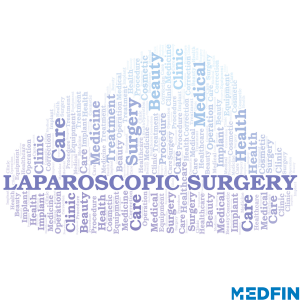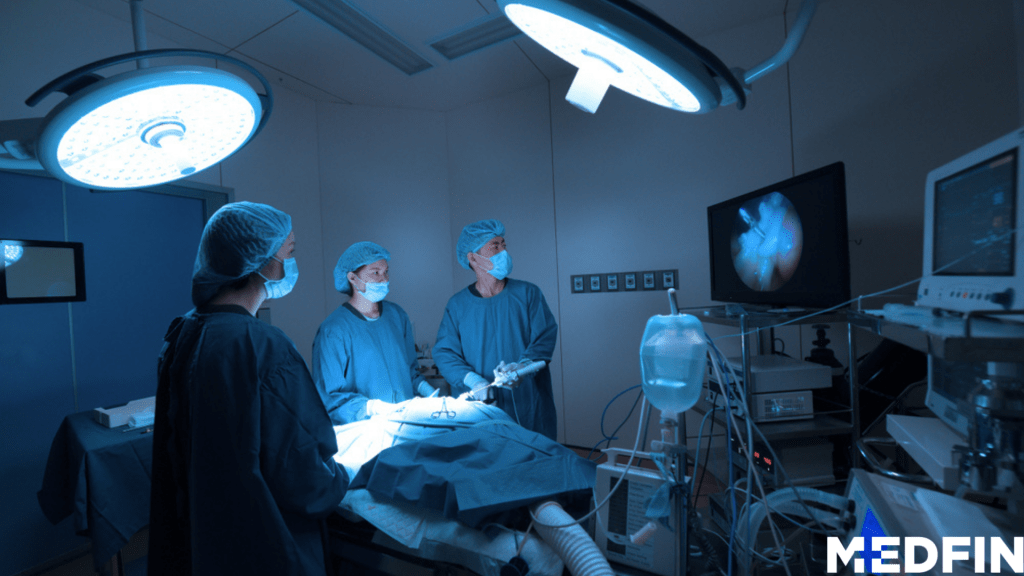Laparoscopic / Latest Treatments
Laparoscopic Surgery: Advantages and Disadvantages

by admin
3rd June 2022
5 minutes read
Laparoscopic surgeries have come out as a great substitute for the traditional methods of surgery. Currently, we have the laparoscopic option to carry out varying surgical procedures thanks to the advancements in technology. Let us see what is the meaning of laparoscopic surgery.
What is laparoscopic surgery?
Laparoscopic surgery or keyhole surgery is a safer and newer method of surgery. These surgeries are minimally invasive.
How does laparoscopic surgery work?
What instruments are used in laparoscopic surgery? As the name suggests, the process involves the use of a laparoscope. A laparoscope is a lean and slender device with a tiny camera and light on its tip. The surgeon starts the operation by making small cuts or incisions of just a few millimeters’ length. S/he then inserts the device and other necessary instruments through these cuts. The camera helps the surgeon to see the video of the inner body on the video screen outside. And thus the surgeon performs the laparoscopic surgery.
Also, in this procedure, the surgeon uses CO2 or carbon dioxide to inflate the abdomen and expand the abdominal walls. You may now think why is carbon dioxide used in laparoscopic surgery. It actually helps the surgeon get a clear view of the internal structures and get enough space to work. Once the operation gets over, the surgeon expels the gas. And finally, s/he closes the incisions with stitches.

Why is Laparoscopic surgery done?
There are numerous benefits of laparoscopic surgeries:
- Minimum bleeding and pain: Bleeding during laparoscopic surgeries is minimum, so is the pain. This is because the incisions are very small compared to those made in open (traditional) surgeries. Additionally, it also reduces the need for blood transfusion to compensate for blood loss.
- Reduced pain and post-surgical bleeding: Even post-surgery, their are reduced risks of pain and bleeding . In open surgery the incision is large. And that requires long-term pain medication to heal. But in laparoscopy, the wound is small and healing is quick.
- Smaller scar: A smaller incision only causes a smaller scar. With a large surgical wound, the scar tissue carries a higher risk of catching an infection. It is more vulnerable to herniation, especially in obese or overweight patients. However, that’s not the case with laparoscopy.
- Lower post-operative infection: Even the risk of post-operative infection is lower. This is because of reduced exposure of internal organs to external contaminants when compared with open surgery.
- Faster healing and quick discharge: Due to fast healing, the patient can go home sooner than that in traditional surgery. S/he can get same-day or next-day discharge. The patient can also return to normal activities sooner.
The abovementioned points clearly answer questions such as does laparoscopic surgery hurt or is laparoscopic surgery outpatient.
Other benefits include in-depth, realistic insight into the body organs, minimum side-effects, less internal scarring, economical procedure, and a higher success rate.
Laparoscopy is useful for both diagnostic as well as surgical purposes. It is a great procedure when the nature and intensity of the problem are not clear. It is helpful when procedures such as X-rays, ultrasounds, MRIs, and CT scans also fail to give results.
Also Read: Laparoscopic Gallbladder Cholecystectomy
What illnesses can be treated with laparoscopy?
Surgeons can perform laparoscopy on several illnesses today. Some of these are:
- Hernia surgeries
- Gallbladder procedures
- Gynaecologic surgeries including hysterectomy
- Abdominal surgeries for the treatment of varying conditions such as appendicitis.
Laparoscopy applies to various body parts. These include the appendix, gallbladder, stomach, pelvis, liver, spleen, uterus, pancreas, urinary bladder, other reproductive organs.
Is laparoscopic surgery safe? Laparoscopic surgeries are the safest when all other non-invasive techniques fail . If you are wondering how to recover from laparoscopic surgery, you can rest assured. The recovery is faster than that with traditional surgical procedures.
That said, let us go through some of the risks of laparoscopic surgery.
Disadvantages of a laparoscopic surgery
There can be several risks of laparoscopy. These include infection, allergic reactions, damage to organs, adhesions, blood clots, internal bleeding, and damage to internal structures.
The surgeon gets a restricted range of movement from the tiny holes. It can be a little difficult to learn to perform this kind of surgery. Also, the surgeon may face difficulty feeling the tissue. This makes it tough for him/her to judge the force that needs to be applied.
Also Read: Hernia: Everything that you need to know
Outlook
Overall, the benefits of laparoscopic surgeries outweigh their disadvantages. Even the risks post laparoscopy are simply resolvable.
Today, laparoscopic surgeries are the most ideal method of performing minimally invasive surgeries.
We at Medfin , the Surgery expert team, offer you access to the latest and most advanced treatment for elective surgeries at the most affordable costs. Our Personal Medfin assistants answer all your concerns about surgery and ensure meeting your needs in your entire medical journey.
Useful Links:
CATEGORIES
- ACL Reconstruction
- Anal Fissures
- Anal Fistula
- Appendicitis
- ASK A DOCTOR
- Benign Prostatic Hyperplasia
- Breast Lump Excision
- Cataract
- Circumcision
- Conditions & Diseases
- Cosmetology
- Covid-19
- Cure
- Endocrinology
- ENGLISH VIDEOS
- Eye Care
- Gallstones
- General Surgeries
- Government Schemes
- Gynaecology
- Gynecomastia
- Gynecomastia
- Health
- Health Insurance
- Hernia
- hindi
- Hip Arthoscopy
- Hip Replacement
- Hip Replacement Surgery
- Hydrocele
- Kannada
- Kidney Stones
- Knee Arthroscopic
- Laparoscopic
- LASER
- Latest Treatments
- Lifestyle
- Liposuction
- Medfin Stories
- Medicine
- Nephrology
- Ophthalmology
- Orthopaedic
- Paraphimosis
- Patient Testimonials
- PCL Reconstruction
- Phimosis
- Piles (Hemorrhoids)
- Pilonidal Sinus
- Proctology
- Prostate Artery Embolization
- Rhinoplasty
- Second Opinion
- Total Knee Replacement
- Uncategorised
- Urology
- uterine artery embolization
- Uterine Fibroids
- Varicocele
- Varicose Veins
- Vascular
- VIDEOS






